
 Ashura is Iran’s most spectacular feast day. On this day, the Shiites commemorate the bloody battle of Kerbala where, in 680 AD the usurping caliph Yazid massacred the rightful leader of Islam, Muhammad’s grandson, Hossein, along with seventy of his companions. It was then that Islam split into two branches, the Sunnis who continued the caliphate, and the dispossessed Shiites, and that was when the Ummah’s governance took a definitive turn in the wrong direction, according to the latter.
Ashura is Iran’s most spectacular feast day. On this day, the Shiites commemorate the bloody battle of Kerbala where, in 680 AD the usurping caliph Yazid massacred the rightful leader of Islam, Muhammad’s grandson, Hossein, along with seventy of his companions. It was then that Islam split into two branches, the Sunnis who continued the caliphate, and the dispossessed Shiites, and that was when the Ummah’s governance took a definitive turn in the wrong direction, according to the latter.
But for the predominantly Shiite Iranians this commemoration, at least in practice, is not so much about mourning as it is about strengthening the community’s bonds by preparing and experiencing the rites of the feast together, by the gathering of relatives and co-workers, by cooking together in the mosque kitchen for thousands of people and sharing the meal. At this time, communities also open up to the stranger – on this day no one can remain lonely –, they invite you in, ask questions, feed you, and display their fundamental kindness in an obvious way. That’s why it is a particularly good experience to come to Iran during Ashura, as the guests who have come with me for this holiday in recent years have raved about it.
But since Ashura comes two weeks earlier each year, and thus has already slipped into the excruciatingly hot summer months, I will not organize a travel group for this feast until it moves into the mild spring months. I, however, miss the feast. That’s why Wang Wei and I have arranged this year to come at this time, only us two.
The first significant object we see from the plane leaving Brussels is NATO headquarters. After that, we don’t really see anything else, because Europe is largely covered by clouds, which only occasionally open up, mainly showing meandering rivers: Do you recognize any of them? By the time we are over Iran, only the urban road networks sparkle out of the darkness like the constellations of an unknown galaxy.
 We pick up the car at Tehran Airport at dawn, and set off for Kashan, two hundred kilometers away. The sunrise, just like last November, reaches us at the foot of the Vulture Mountains.
We pick up the car at Tehran Airport at dawn, and set off for Kashan, two hundred kilometers away. The sunrise, just like last November, reaches us at the foot of the Vulture Mountains.



At 8 am, the streets of Kashan are still almost deserted. However, they are already covered in festive decorations: red and black flags reminiscent of blood and mourning, as well as pious sayings and posters with the symbols of the martyrs of Kerbala and the image of the Great Mosque of Kerbala, which often include portraits of local people who havee died in recent years. Dates lie in front of the mosques, that is, Hossein’s symbolic coffins, which will be carried around in tomorrow’s grand procession. On the main square, some early risers are fixing the inscriptions of the festive podium.
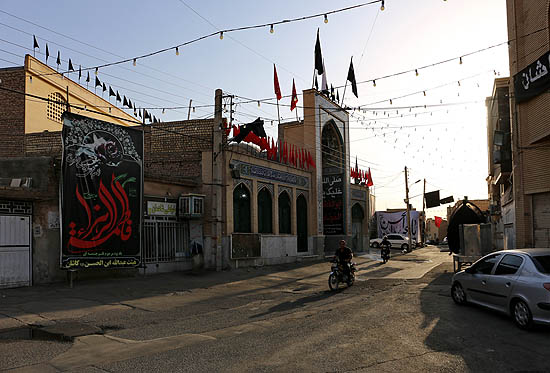

 When we start walking around in the old town late in the morning after a few hours of sleep, we witness one of the most important preparatory rites of the holiday: the slaughter of the dinner animal, in front of the nearby mosque. Three thousand servings of pilav, rice with vegetables and meat are made from such a cow, in which there will be hardly any meat, only the taste of its juice. The beautiful animal is slaughtered at the casual slaughterhouse in the halal way, that is, with its blood drained out, and it is cut up in a matter of seconds by experienced hands. The operation is directed by the chef of the mosque, who has a broken leg, sitting on a chair, and giving commands with few movements, like a godfather. The audience watches spellbound.
When we start walking around in the old town late in the morning after a few hours of sleep, we witness one of the most important preparatory rites of the holiday: the slaughter of the dinner animal, in front of the nearby mosque. Three thousand servings of pilav, rice with vegetables and meat are made from such a cow, in which there will be hardly any meat, only the taste of its juice. The beautiful animal is slaughtered at the casual slaughterhouse in the halal way, that is, with its blood drained out, and it is cut up in a matter of seconds by experienced hands. The operation is directed by the chef of the mosque, who has a broken leg, sitting on a chair, and giving commands with few movements, like a godfather. The audience watches spellbound.

The holiday oozes out from the corners of the bazaar and gathers into one big pulsation in the bazaar’s large spaces, and then the next day on the main streets of the city.  The Kashan bazaar is a corridor covered by a row of domes running along the entire width of the old town, to which many other smaller corridors, caravanserais, shops and courtyards are connected. Members of a trade or guild gather in one of these larger shops or courtyards, and then step out onto the section of corridor in front of them and begin their own ceremony. The lead singer – you could say, the cantor – sings into the loudspeaker the simple-texted, long-repeating songs about Kerbala, the heroism of Hossein and his companions, our reverence for them, and the grief of his mother and all of us with her. And the others sing with him and beat their chests to the rhythm of the song.
The Kashan bazaar is a corridor covered by a row of domes running along the entire width of the old town, to which many other smaller corridors, caravanserais, shops and courtyards are connected. Members of a trade or guild gather in one of these larger shops or courtyards, and then step out onto the section of corridor in front of them and begin their own ceremony. The lead singer – you could say, the cantor – sings into the loudspeaker the simple-texted, long-repeating songs about Kerbala, the heroism of Hossein and his companions, our reverence for them, and the grief of his mother and all of us with her. And the others sing with him and beat their chests to the rhythm of the song.  Then the procession starts towards the magnificent Timche-ye Amin od-Dowle caravanserai or rather plaza at the west end of the bazaar, where each group has a set time to perform. This is the most appropriate term for a ceremony where lead singers ‘rap’ on stage and their followers swing their arms to the rhythm of the song: they raise their arms above their heads, beat their chests, then lower them again and again.
Then the procession starts towards the magnificent Timche-ye Amin od-Dowle caravanserai or rather plaza at the west end of the bazaar, where each group has a set time to perform. This is the most appropriate term for a ceremony where lead singers ‘rap’ on stage and their followers swing their arms to the rhythm of the song: they raise their arms above their heads, beat their chests, then lower them again and again.
When clips of the Ashura ceremony are sometimes shown on Western TV, they mostly try to convey the impression of fanatical crowds. In my personal experience, there is nothing fanatical about these ceremonies. Any football crowd is more fanatical. It’s more like dancing at a festival concert. After the singing and dancing the participants spread out to drink tea, smiling contentedly and talking cheerfully. They happily allow themselves to be photographed, and they even invite you to take photos, and at the end they even thank you for it.

A novelty is that the portrait of General Qasem Soleimani, the head of the Revolutionary Guard’s Quds Corps responsible for military operations outside Iran, who was killed by a targeted American drone attack in Iraq in January 2020, is hanging in the most important place of the stage, in the middle between the two great ayatollahs Khomeini and Khamenei. As the leader of Iran’s fight against the Islamic State, Soleimani was extremely popular in Iran, and his assassionation was condemned not only by the regime, but also by the majority of the population. On this year’s Ashura, surely on higher orders, he takes the center stage, as if assuming the role of Hossein as a martyr, thereby automatically casting the US into the role of the evil caliph Yazid.

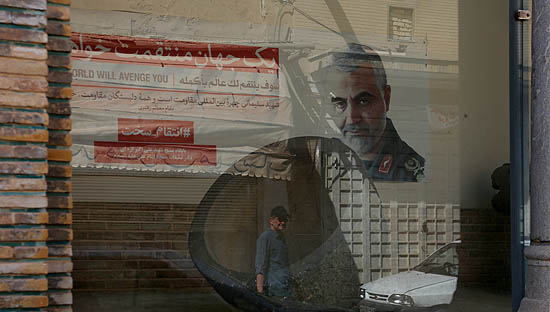
Women are conspicuously absent from these recordings. The celebrations are done by men. But women are also present, they gather in the shops and workshops. Now we are just two men, so it was not appropriate for us to go inside, that’s why they are missing from the photos. But if there are women with us, the whole group is always called in, fed, and we can entertain the children.
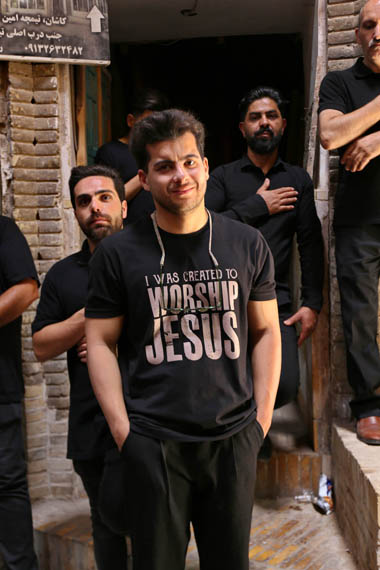 A dissenter at the Ashura ceremony. As I ask for permission to take the photo by raising the camera and nodding, he smiles, it seems that he knows why I am taking the photo.
A dissenter at the Ashura ceremony. As I ask for permission to take the photo by raising the camera and nodding, he smiles, it seems that he knows why I am taking the photo.
In the corridors of the bazaar, on the streets, in the courtyards of the mosques and around them, everywhere they offer something: tea, soft drinks, cakes, chocolate, melons. Mosques set up their own snack stalls at the entrance and on nearby street corners. An integral part of the holiday is that people meet at these stalls, they take a tea or a soft drink, exchange politeness formulas for a long time until they drink it, and then move on. A fundamental element of Persian public communication is that when people meet each other, they address a series of warm, respectful gestures to each other. By the time you reach the end of the street, you have received so many such gestures that you necessarily feel good and in your place in the world. This rite and feeling greatly contributes to the maintenance of social health in a world threatened from as many sides as the life of the Iranian people. And you, an outsider, are also included in this. At every stand, they invite us, offer food and drink, ask questions, try to find common ground. This is not difficult with Wang Wei, since everyone knows Catalonia, Barcelona and Messi. The few objecting Real Madrid fans are booed together.
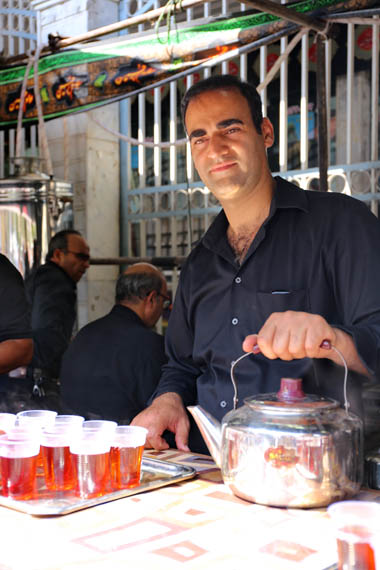

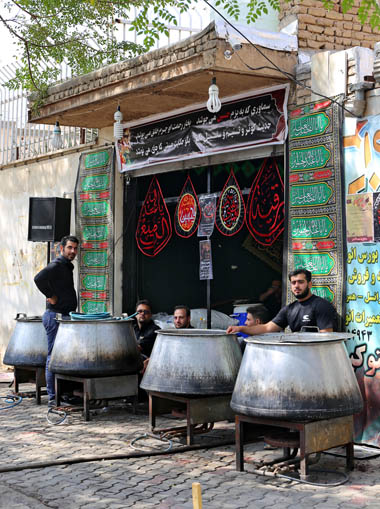
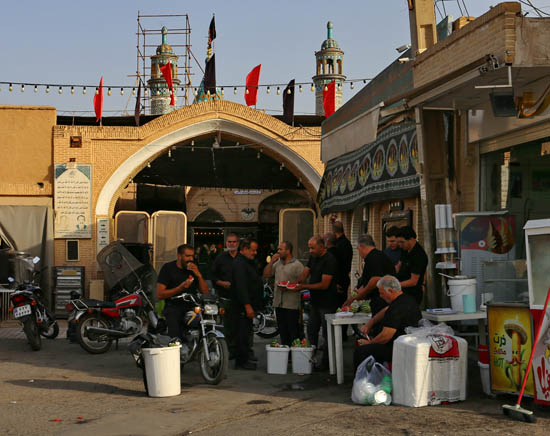
 Cooking sweet saffron rice in the courtyard of a private house next to a mosque. It is just as wonderful a men’s pastime as cooking goulash at a garden party. You are in a good mood even without alcohol.
Cooking sweet saffron rice in the courtyard of a private house next to a mosque. It is just as wonderful a men’s pastime as cooking goulash at a garden party. You are in a good mood even without alcohol.
The top of the offering is the midday and evening meal. In the morning, animals were slaughtered at each mosque, from which thousands of portions of rice with vegetables and meat are cooked at noon and in the evening, which are distributed in styrofoam containers to the community of the mosque and anyone passing by. People either eat it on the spot, chatting with each other, or take it home. Anyone can get as much as they want – some people take seven or eight containers –, and no one says anything about it. They probably know how big their families are. This gesture of charity is so unlimited that whenever I bring a group for Ashura, fifteen or twenty of us usually stand in front of a mosque’s kitchen, and they happily feed us. If only because all restaurants are closed on these two days. When we came for the first time, twenty Europeans in front of a mosque kitchen, it caused such a stir that Kashan TV came out to interview us.
The point of Ashura and other Shia feasts is pretty much like that of the Jewish ones: “They tried to kill us, but they did not manage to, so let’s eat!” During one of our Ashura visits, after dinner, the local mullah invited our group to the mosque, among the believers keeping night vigil, and asked the question: “Agha Tumas, you have been to Ashura several times. What did you learn from the behavior of Imam Hossein and his companions?” To which I replied: “I have yet to delve deeper into the behavior of Hossein and his companions. But I learned the following from the behavior of the Persians. Most countries in the world celebrate a glorious event as their national holiday: the day of independence, victory over the enemy, a revolution. Iran’s national holiday is a great defeat. A defeat that has been teaching the Persians for fifteen hundred years that you can get back up from every defeat.” My less religious Persian friends, who were also present, later thanked me for making the feast meaningful to them.
And another story: I am sitting in Yazd in a vaulted alley. Before me are passing, from the nearby mosque, after the lengthy post-Ashura ceremony, women, men and children dressed in black, carrying in a plastic bowl the festive free meal distributed in the mosque, some kind of pea pottage. I am watching them. A short, young, yet already broken man with a very young woman – maybe his wife, maybe his daughter –, and with a little child behind him, approaches, with two plastic bowls in his hands. I’m just thinking about how much he might need this free meal, when he passes before me, smiles at me, and offers to me one of the two bowls: “Befarmâid”, please. I smile back, and bow a little bit, with my hand on my chest, as a sign of polite rejection: “Motshakkeram”, thank you so much. He nods, they go on.
In the pictures below, the chef of my friend Mehdi’s mosque proudly shows the kitchen where five thousand meals are cooked in each of the two days of the feast.
The absolute winners of the feast are the children. If they come with their parents, they are at the center of the company, but mostly even the very little ones become independent, hang out with each other, visit the stalls, and organize their own small parades. They also communicate bravely and openly with strangers.
The first, preparatory day of the feast, Tasuʿa (“the ninth”, because it is the ninth day of the Islamic month of Moharram) ends slowly. In most mosques, it does not even end, because the believers imitate Hossein and his companions, who kept vigil and prayed all night before the next day’s battle. This is what they do in the mosques and in many private houses as well: They take turns singing and listening to the storytellers who go from house to house, narrating in colorful and vivid details the battle and the martyrdom of the heroes.
Early next morning, we set out to go up to the Vulture Mountains, to the historic town of Abyaneh, where we want to participate in the great festival of Ashura (Ashura = “the tenth”). Making our way to the car from the labyrinth of the old town of Kashan, we become involved in the morning ritual of a mosque. They invite us for an iced soft drink. If yesterday’s procession was for men, the morning ceremony is surely for women, who flock to the mosque from all directions around 8 am. In the courtyard, they touch and kiss Hossein’s symbolic coffin, then enter the mosque, where the songs sung by men yesterday are heard, now performed by women.
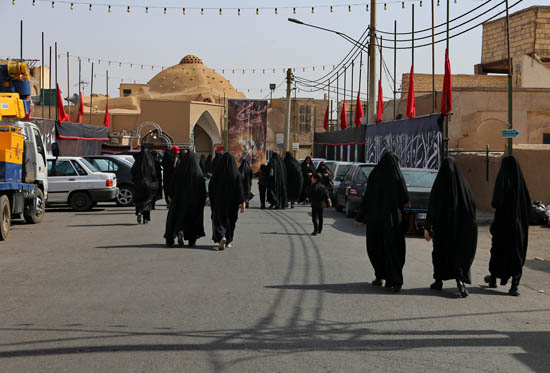

When we reach the main road, we witness a wonderful flashmob. In the still deserted street, a truckload of men dressed in black suddenly pulls up, then another and another. They jump down, line up and begin the mourning ceremony for Hossein. Five minutes later, they jump onto the truckbeds, and as if they had never been there, the street is empty again.

The second day of the Ashura feast, the actual feast day, is for the remembrance of the martyrdom of Hossein and his companions in Kerbala. The most important symbol is the nakhl, the “date”, Hossein’s symbolic coffin, a date-shaped large structure of wood, covered with mourning shrouds, which is carried around by handles extending from the front, back and sides. While on the previous, preparatory day, the commemoration took place in small groups, in closed places, the bazaar, mosques and back home, today the whole community pours out into the streets and goes around the center of the city in a huge joint procession. The Ashura procession has its own specific tradition in each city. We had been to Kashan several times. Now we are going to participate in Abyaneh.
 I have written several times about Abyaneh, the Red Village hidden in the heart of the Vulture Mountains: once a summary, then a brief report about our visit to the complex of the local mosque and Zoroastrian temple closed to foreigners, and once specifically about the Ashura celebrations of the town, with the photos of Iranian photographers. Now we finally want to see this colorful celebration with our own eyes.
I have written several times about Abyaneh, the Red Village hidden in the heart of the Vulture Mountains: once a summary, then a brief report about our visit to the complex of the local mosque and Zoroastrian temple closed to foreigners, and once specifically about the Ashura celebrations of the town, with the photos of Iranian photographers. Now we finally want to see this colorful celebration with our own eyes.
Abyaneh has been closed to foreigners for years on this day. Only the residents of the village and those descending from the place can enter the village and participate in the ceremony, thus protecting the intimacy of the feast. But anyone can book a room in the two local hotels for this day. We did so well in time, and we flag our booking to the policemen standing at the occasional roadblock of the mountain road winding up from the Natanz road towards Abyaneh.
 Winding up into the valley, an imposing fortress faces us from the mountainside. This is Hanjan Fortress, which was built by the Sassanid governors to protect the valley. A veritable Desert of the Tartars fort – by the way, Zurlini shot the Desert of the Tartars movie in a similar Iranian fort –: it has steadfastly protected the valley from the enemy for fifteen hundred years, but the enemy just didn’t want to come. The Arabs who conquered Persia did not think that there could be anything interesting inside the barren mouontain rising in the middle of the desert, so they did not penetrate the valley for a thousand years. The fortress was kept in good order by the locals for centuries, it was used to store their crops and valuables, but it began to fall into disrepair after the Islamic Revolution. Unfortunately, this is a common phenomenon in Iran. Many thousands of similar castles still stand throughout the country, but they were declared a symbol of the fallen regime and are not cared for. Since they are made of clay, a few decades are enough for the heritage of two thousand years to crumble to dust. It seems that the locals are just now starting to restore the ruins of Hanjan fortress: with bricks and concrete instead of the traditional technique, but at least it will not perish. In the main square of the nearby Hanjan village, the rustic monument and the Islamic poster encouraging the wearing of the headscarf indicate the current cultural standard.
Winding up into the valley, an imposing fortress faces us from the mountainside. This is Hanjan Fortress, which was built by the Sassanid governors to protect the valley. A veritable Desert of the Tartars fort – by the way, Zurlini shot the Desert of the Tartars movie in a similar Iranian fort –: it has steadfastly protected the valley from the enemy for fifteen hundred years, but the enemy just didn’t want to come. The Arabs who conquered Persia did not think that there could be anything interesting inside the barren mouontain rising in the middle of the desert, so they did not penetrate the valley for a thousand years. The fortress was kept in good order by the locals for centuries, it was used to store their crops and valuables, but it began to fall into disrepair after the Islamic Revolution. Unfortunately, this is a common phenomenon in Iran. Many thousands of similar castles still stand throughout the country, but they were declared a symbol of the fallen regime and are not cared for. Since they are made of clay, a few decades are enough for the heritage of two thousand years to crumble to dust. It seems that the locals are just now starting to restore the ruins of Hanjan fortress: with bricks and concrete instead of the traditional technique, but at least it will not perish. In the main square of the nearby Hanjan village, the rustic monument and the Islamic poster encouraging the wearing of the headscarf indicate the current cultural standard.


 We met a procession already before Abyaneh. At the access road of the previous village, Tareh, a fighter-bomber is standing from the time of the Iraq-Iran war. On the socle, there are photos and names of local men who lost their lives mainly in the air force. The monument is officially called the “Memorial Museum of the Martyrs of Tareh”. The Ashura procession of the village starts from here, connecting the memory of the ancient martyrs with that of the 1980s, just like everywhere else in Iran. It would be nice to photograph them standing next to the plane, but by the time we manage to stop and get out, the procession has already started down the road to the village.
We met a procession already before Abyaneh. At the access road of the previous village, Tareh, a fighter-bomber is standing from the time of the Iraq-Iran war. On the socle, there are photos and names of local men who lost their lives mainly in the air force. The monument is officially called the “Memorial Museum of the Martyrs of Tareh”. The Ashura procession of the village starts from here, connecting the memory of the ancient martyrs with that of the 1980s, just like everywhere else in Iran. It would be nice to photograph them standing next to the plane, but by the time we manage to stop and get out, the procession has already started down the road to the village.
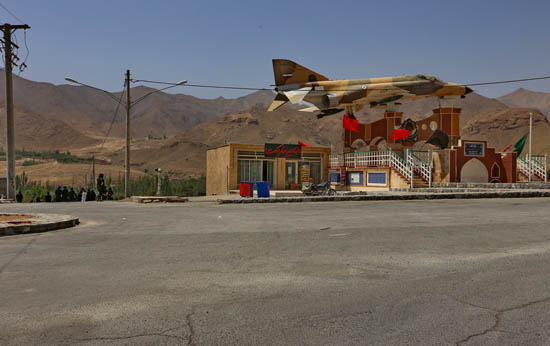
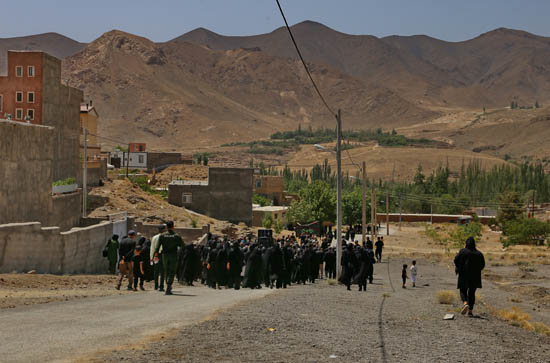
In Abyaneh, the tea stall was set up on the main street. The people of the town sit around it and chat. Although the village has only four hundred permanent residents, nevertheless those living in Isfahan, Tehran, and even abroad come home for this holiday. We talk to people whose parents weren’t even born here, but since childhood they come back every year for every major holiday, and they maintain the image of the virtual population and the real house – that’s why the built heritage of the town is not significantly decaying, despite the residents, who are few and aging. At such times, they usually also wear the local folk costume, the men loose black silk trousers, the women floral skirts and a white shawl sprinkled with roses, a remnant of the former Zoroastrian dress. In addition to tea, they go around again and again offering soft drinks, chocolates and melons.

Abyaneh has not one, but two processions. Adult men carry a large date, Hossein’s coffin, and it is followed by a small date carried by the children. In the morning, it seems, they carry them back and forth along a narrow street of the old town only for the sake of warm-up and spectacle, accompanied by groups singing Ashura songs. In the afternoon, however, they are also joined by “Hossein’s army”, a heavy metal decoration, whose individual feathers symbolize soldiers. This is carried by men in turn, followed by a procession of self-flagellants. Until the 19th century, this was a rather bloody cult, but today even the most ardent beliver cannot do much harm with the little, symbolic whip. The dates and the army start at about 1 pm to go around in and outside the old town. It’s a strange sight how the date sways forward in the narrow streets, like an elephant with its caretaker in the sadddle. In the meantime, the members of every family distribute the usual delicacies to everyone present.
The “army” and the walls of the ouses are decorated with portraits of those who died the previous year. The “cantor” also evokes the deceased at each stop. This kind of identification with the martyrs makes the commemoration personal for the participants and gives them the opportunity to express their individual grief by mourning for Hossein.

At dusk, the whole town gathers again in the center. Dinner is now being served in the mosque kitchen. Here, every local eats his or her container sitting and talking to the others, since they so rarely see each other. They quickly notice the helpless stranger, and they escort us in a chain of five men all the way to the kitchen, where we also get two portions. And we also get conversation partners. Two twenty-year-old boys want to practice their fairly good English skills. They are architects, but they are interested in history, that’s what we are talking about. It is deplorable how much the Islamic state closes off all sources of information from them. Whatever they know from world history, they get from the game Assassin’s Creed, and it is surprisingly correct. But they are completely at a loss when it comes to very basic issues, and so they are prone to simplifications, short-circuits and conspiracy theories. They are also not helped by the limited book publishing and the miserable internet in Iran. Later, in some museums, young guides give a sample of their knowledge, and this is also dominated by the lack of solid information and quickly drawn large metaphysical connections. This might give an incentive to art, film, photography, visual arts, in which Iran is now a leader, but it will take its toll anyway.
“Do you know why the Iranian government cooperates with the Russian?” asks one of the boys concerning the current Russian-Ukrainian war, about which the regime is silent and the Iranians have little idea. “Because they are both unbelievers.” It is perhaps understandable that the news about the atheist Soviet leadership having switched to the Christian-Fascist Russian one has not yet reached Iran. But in order to call the first theocratic government of the 20th century one of unbelievers, you need the daily experience of the hypocrisy of the Iranian system of national cooperation. And that this fact finds in the two system a common denominator, you need the connection-making power of an imagination unshackled by solid information.

Early next morning, the streets of the village are still deserted, but completely clean. The huge amount of waste is gone, the bins are empty, only the Ashura decorations are still out on the walls. But the little whips are already neatly collected in the back of a van. An old woman opens the door to the sound of our footsteps on the main street. She tries to sell us a kilo of apricots for a little money, with success.
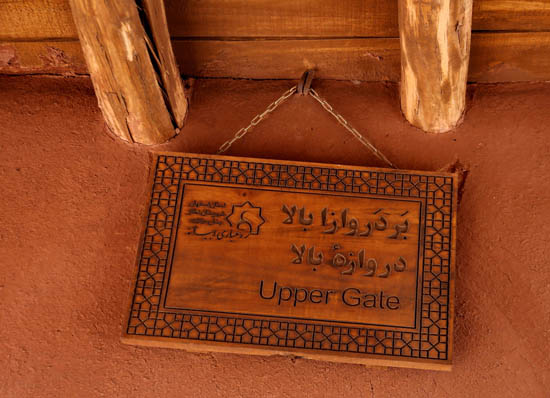 Unlike the rest of Iran, where local languages are not supported, everything in Abyaneh is written alongside Persian, and even above in it, in the local vernacular, which is close to the Sassanid Middle Persian of the first centuries AD, and is locally called “zabân-e Zartosht”, the Zoroastrian language. The gate is darvâze in modern Persian, and bardarvâzâ in the thousand-year-old language.
Unlike the rest of Iran, where local languages are not supported, everything in Abyaneh is written alongside Persian, and even above in it, in the local vernacular, which is close to the Sassanid Middle Persian of the first centuries AD, and is locally called “zabân-e Zartosht”, the Zoroastrian language. The gate is darvâze in modern Persian, and bardarvâzâ in the thousand-year-old language.
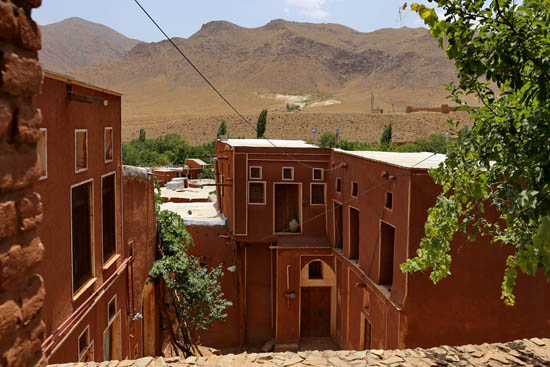
 We want to visit the Zoroastrian sanctuary outside the village, between the mountains. I have known for a long time that it existed (although it is not marked on the maps), but in my previous visits to Abyaneh, I have never had two free hours to walk there and back. This morning I finally have it.
We want to visit the Zoroastrian sanctuary outside the village, between the mountains. I have known for a long time that it existed (although it is not marked on the maps), but in my previous visits to Abyaneh, I have never had two free hours to walk there and back. This morning I finally have it.
Abyaneh, hidden in the middle of the barren Vulture Mountains that rise in the middle of the desert, was never discovered by the Arab conquerors, and the inhabitants of the village were careful enough not to give any news of themselves for centuries. This is how they preserved their archaic language, clothing and Zoroastrian religion. The first – already Persian – Muslim preachers reached them only in the 1500s, and their Zoroastrian sanctuaries were still functioning in the 19th century.
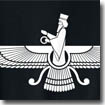 The Zoroastrian religion was named after its founder, the Eastern Iranian Zarathushtra (Zoroaster in Greek). He lived sometime between the 12th and 6th centuries BC and transformed the local version of the ancient Indo-European religion of twelve chief gods under one supreme god into the first monotheism. In his teaching, the chief gods are actually only archangels – the twelve Persian months still bear their names –, and there is only one god, Ahura Mazda (meaning the greatest and the wisest), who created them as well. Ahura Mazda created the world to be good, but not perfect: from the beginning it contains the evil in the form of decay (entropy), which was later personified in the form of the evil Ahriman. Man’s main purpose is to work against entropy as a kind of maintenance staff, to restore the decaying world, to bring joy and happiness into it. For this, he can expect no reward, and no punishment for negligent maintenance. People do good for its own sake, because it is the only right and meaningful action. Zoroastrianism has neither heaven, nor hell. At the end of the maintenance work – that is, death – man’s work clothes, that is, his body is cleaned up by vultures, and his soul – everyone’s soul – returns to Ahura Mazda.
The Zoroastrian religion was named after its founder, the Eastern Iranian Zarathushtra (Zoroaster in Greek). He lived sometime between the 12th and 6th centuries BC and transformed the local version of the ancient Indo-European religion of twelve chief gods under one supreme god into the first monotheism. In his teaching, the chief gods are actually only archangels – the twelve Persian months still bear their names –, and there is only one god, Ahura Mazda (meaning the greatest and the wisest), who created them as well. Ahura Mazda created the world to be good, but not perfect: from the beginning it contains the evil in the form of decay (entropy), which was later personified in the form of the evil Ahriman. Man’s main purpose is to work against entropy as a kind of maintenance staff, to restore the decaying world, to bring joy and happiness into it. For this, he can expect no reward, and no punishment for negligent maintenance. People do good for its own sake, because it is the only right and meaningful action. Zoroastrianism has neither heaven, nor hell. At the end of the maintenance work – that is, death – man’s work clothes, that is, his body is cleaned up by vultures, and his soul – everyone’s soul – returns to Ahura Mazda.
Just as the central concept of Christianity is love, so that of Zoroastrianism is truth. Lying increases entropy in the world, so it is a meaningless and harmful action, contrary to one’s goals. According to Herodotus – who offers a detailed anthropology of the Persians and their religion in his Histories (1.136) – the young Persian only had to learn three things before the age of twenty: to ride well, to shoot arrows, and to tell the truth.
Although Islam recognized Zoroastrianism as one of the religions of the book, they were forcibly converted to Islam after the Arab conquest. Today there may be some 100 to 200 thousand Zoroastrian believers, above all in central Iran, in and around Yazd, and in Western India, where many of them fled from the violent conversion campaigns.
The village is surrounded by orchards. The gardens are irrigated by a network of canals, and the trees are even now sagging under the crop of apples, plums and walnuts. It is still early in the morning, but several people are already coming back with the morning harvest. Looking back from the first barren hills beyond the gardens, you can see the red village creeping up the mountainside.
The shrine stands alone among the barren red mountains at a point where a strong-flowing stream breaks through a dramatic rock face.
Herodotus writes that the Persians do not build their temples in cities, but in nature, on mountaintops, next to springs and similar places, where the forces of nature, or in general the essence of reality manifests itself. Károly Kerényi calls such manifestations epiphanies, and considers their cult to be the essence of ancient religions. Zoroastrianism was also an epiphanic religion, although it did not personify the forces manifested in this way, unlike the Greeks, but traced them back to Ahura Mazda. In the Sassanid era (AD 2-7th c.), when Zoroastrianism had to compete with increasingly urban religions – Christianity, Judaism, Manichaeism –, they began to build sanctuaries in the cities as well. In Abyaneh, such is the small shrine on which the local mosque was built, as well as the former fire temple, the construction of which was attributed to Harpak, chief minister of the great shah Khosrow II (590-628), who is said to have come from Abyaneh. These have not been used since the 18th century, but the sanctuary outside the city – which was renovated in 1881 according to its inscription, but which is probably the oldest of all – was visited even as late as the 20th century.
From the outside, the present-day sanctuary is a featureless cube at the base of the rock wall, next to the stream. Upon entering, you are greeted by a pillared courtyard, with 19th-century Qajar-style stucco on the opposite side: two angels supporting a building inscription, flanked by a deer and a ram. A huge plane tree (Old World sycamore, Platanus orientalis) with many trunks grows in the yard. It is quite old, but probably consists of lateral shoots of an even older tree.
The sycamore was the sacred tree of the Zoroastrians. Old sycamores stand in front of most of the ancient Zoroastrian shrines converted into mosques, as well as in the Zoroastrian shrine of Chak Chak, which is still in use today. Herodotus mentions that Xerxes, marching with his army to Greece, on his way
“…saw a delightfully beautiful sycamore tree. He embellished it with golden ornaments, and entrusted one of his immortals with its guarding.” (Historiae, 7.31)
However, the courtyard is only the front porch of the actual shrine, to which a door decorated with stucco and mirror inlays opens to the left. This shrine is actually a cave in the rock, which has a fireplace for the eternally burning fire, and probably a narrow branch of the stream, which has since been diverted, was also introduced here so that the four sacred elements – fire, water, earth, air – were all present. This was certainly the original sanctuary, built many centuries BC, and the forecourt, renovated in 1881 was later added to it.
The church is abandoned, but still in relatively good condition. They might have stopped visiting it only after the Islamic revolution. They scribbled graffiti on its walls, but otherwise they keep it clean, they don’t destroy it. The plastic poster stretched on the back wall of the courtyard also calls for its protection. It is a great experience to stand here, on such an island of the living past. How long will it stay this way?
 On the way back, we take a small detour, passing the Sassanid-era clay fortress opposite the town. The fortress is actually just four round towers with clay walls between them. “It was not used to station any army”, explained one of the local men the night before, “but so that the people and the animals could seek refuge here for a few days in the event of an attack.” “Who would have attacked the town here among the mountains, where the enemy never entered?” I ask him. “Well, we ourselves produced the enemy. The robbers, the outlaws.”
On the way back, we take a small detour, passing the Sassanid-era clay fortress opposite the town. The fortress is actually just four round towers with clay walls between them. “It was not used to station any army”, explained one of the local men the night before, “but so that the people and the animals could seek refuge here for a few days in the event of an attack.” “Who would have attacked the town here among the mountains, where the enemy never entered?” I ask him. “Well, we ourselves produced the enemy. The robbers, the outlaws.”
At the base of the fortress are clay buildings of former farms, with cracked roofs and crumbling walls. For the owners living in big cities, it is enough to maintain the ancient house in the old town of Abyaneh, they have no energy for the farm buildings. From here, you can see the whole town at the base of the big red rocks and the even bigger gray rocks towering behind them.
 On the way back from Abyaneh to the Natanz-Isfahan road, we stop two villages away, at the archaic cemetery of Komjan. Above each grave there are two triangular flat stones, at head and at foot, with an inscription and some schematic figures. These figures represent the sun and the moon, cypresses, the trees of the cemetery, but most interestingly, some of the headstones have schematic human faces. I don’t know this from any other Iranian cemetery, this must be the valley’s own tradition.
On the way back from Abyaneh to the Natanz-Isfahan road, we stop two villages away, at the archaic cemetery of Komjan. Above each grave there are two triangular flat stones, at head and at foot, with an inscription and some schematic figures. These figures represent the sun and the moon, cypresses, the trees of the cemetery, but most interestingly, some of the headstones have schematic human faces. I don’t know this from any other Iranian cemetery, this must be the valley’s own tradition.
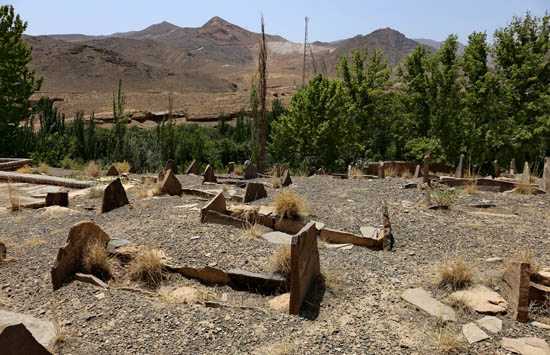

We reach down to the foot of the Vulture Mountains. If I just compared the fortress of Hanjan to that of the Desert of the Tartars: well, then this is the Desert of the Tartars itself, the exemplary desolate plain at the foot of the menacingly jagged barren mouontains, on the edge of which the enemy’s fur-capped, spear-shaking horsemen can appear at any time, but they never will, because they too consider such theatricality a useless effort. Only small whirlwinds sweep from time to time among the dried-up succulent bushes, which store life in their roots for the one or two short rains a year. If I turned back now – which I won’t do –, I would see the above-ground buildings of the Natanz uranium enrichment plant behind me, surrounded by the guns of the dug-in tanks facing the four winds.
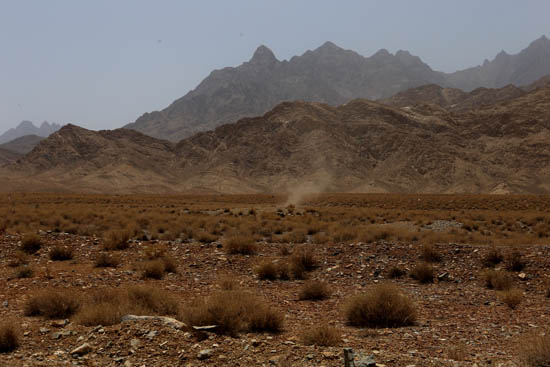
 The old main street of Natanz is covered with a mass of red and black flags. Even before reaching the great mosque, the sight of a magnificently decorated hosseiniye prompts us to stop. Hosseiniyes are spacious courtyards or squares surrounded by arcades, which are used for Shiite ceremonies involving many people – mainly for Ashura, Hossein’s funeral feast, as their name suggests. In their midst, there is usually a date as a memorial, Hossein’s symbolic coffin, which is moved and carried around only in this day. It is richly decorated for the vigil before Ashura, and the sacred theater of taʿziye, presenting the lives of the twelve imams, are performed here in the ten evenings following the holiday. Every mosque must have a hosseiniye, if nothing else, a public square appropriated for the holiday. The people of each mosque compete with each other in decorating their hosseiniyes.
The old main street of Natanz is covered with a mass of red and black flags. Even before reaching the great mosque, the sight of a magnificently decorated hosseiniye prompts us to stop. Hosseiniyes are spacious courtyards or squares surrounded by arcades, which are used for Shiite ceremonies involving many people – mainly for Ashura, Hossein’s funeral feast, as their name suggests. In their midst, there is usually a date as a memorial, Hossein’s symbolic coffin, which is moved and carried around only in this day. It is richly decorated for the vigil before Ashura, and the sacred theater of taʿziye, presenting the lives of the twelve imams, are performed here in the ten evenings following the holiday. Every mosque must have a hosseiniye, if nothing else, a public square appropriated for the holiday. The people of each mosque compete with each other in decorating their hosseiniyes.
The current form of the Ashura decoration largely developed in the Qajar era (1794-1925), and has inherited the pictorial formulas of that period. Such is the lion carrying a sword on the canvas roof of this hosseiniye, called shir-e-khorsid, which was the coat of arms of the shahs for many centuries. It was also in the middle of the national flag until the islamic revolution banished it from there. Considering this, it is astonishing that it could stay, without any religious antecedents, in the decoration of the holiest holiday. And the figures of the Qajar period are placed on the most important element of the decoration, the metal alamat, which is carried around during the Ashura procession, but then it stands in the center of the hosseiniye until the decorations are taken down. Alam originally means flag, in this context Hossein’s flag, which usually have the inscription يا حسين „ya Hossein”, oh Hossein! (or rather Hossein, help us!), accompanied by Quranic quotations or the pictures of the main martyrs of Kerbala. The Arabic plural form alamat is a complex metal construction, which, in addition to the copper, peacock and ostrich feathers symbolizing Hossein and his warriors, also have the animal symbols of the visual world of the Qajar folklore: birds, lions, deer, gazelles, dragons, and the most unusual, the bird-bodied shirin with a human face.
The Ashura procession is often accompanied by live pictures reenacting the battle and its characters. An example of this is the symbolic installation of Hossein’s camp next to this hosseiniye, parading the most important symbols of the feast: Hossein’s green tent, the hose with which Abolfazl, Hossein’s half-brother and the other great hero of Ashura, went down to the Euphrates on the morning of the battle to bring water to the thirsty children and women, the bloody white horse that came back alone after the slaughter of Abolfazl, and the flag with Abolfazl’s severed hand on top of its staff, which replaces the usual crescent in most Shiite mosques. Next to the installation, there are traces on the ground demonstration the complexity of yesterday’s ceremony: scattered candles, tops of soda cans snapped off and cigarette butts.

 Walking futher towards the mosque, we see the same wax stains on the steps of the atashgah, the so-called Zoroastrian fire temple. There are two possible explanations for this. One is that the ardent Muslim believers in Natanz want to include the infidel monuments in the Islamic cult as has happened so many times in the past with sanctuaries converted into mosques. The other is that neo-Zoroastrians held a counter-ceremony here. A superficial cult of Zoroastrianism as the ancient pre-islamic Persian religion is popular mainly among young people who reject the Islamic regime. However, there is something strange about this fire temple. The unusual four-gate structure and its masonry technique both refer to 20th-century construction. It was probably built under the Pahlavi shahs, who were great supporters of the cult of ancient Persia and its religion. After all, the original Zoroastrian temple certainly stood on the site of the 11th-century mosque. It was converted into the mosque, as it was the Muslim custom throughout Western Iran.
Walking futher towards the mosque, we see the same wax stains on the steps of the atashgah, the so-called Zoroastrian fire temple. There are two possible explanations for this. One is that the ardent Muslim believers in Natanz want to include the infidel monuments in the Islamic cult as has happened so many times in the past with sanctuaries converted into mosques. The other is that neo-Zoroastrians held a counter-ceremony here. A superficial cult of Zoroastrianism as the ancient pre-islamic Persian religion is popular mainly among young people who reject the Islamic regime. However, there is something strange about this fire temple. The unusual four-gate structure and its masonry technique both refer to 20th-century construction. It was probably built under the Pahlavi shahs, who were great supporters of the cult of ancient Persia and its religion. After all, the original Zoroastrian temple certainly stood on the site of the 11th-century mosque. It was converted into the mosque, as it was the Muslim custom throughout Western Iran.  A proof of this is the wonderful sycamore tree grove that stands in front of the mosque today, but whose old trees are the shoots of the ancient one that stood in front of the former Zoroastrian shrine. Their age is estimated at two thousand years.
A proof of this is the wonderful sycamore tree grove that stands in front of the mosque today, but whose old trees are the shoots of the ancient one that stood in front of the former Zoroastrian shrine. Their age is estimated at two thousand years.

 This mosque represents the prototype of Iranian mosques, the four large arches (eivans) around a square courtyard. The area around its mihrab is particularly nicely decorated with Seljuk-era stucco and Safavid-era calligraphy. The wall of the eivan opposite, next to the entrance, is decorated with folk graffiti close to Ashura in spirit: Ali’s double-edged sword, the Zulfikar, and a bunch of hands laid on the plaslter and drawn around, thus expressing the believer’s identification with Abolfazl, whose hand carrying the hose was cut down by the enemy. Such and other sacred graffiti are held in high esteem, they are not destroyed, but as you can see, they are preserved even in the course of a restoration.
This mosque represents the prototype of Iranian mosques, the four large arches (eivans) around a square courtyard. The area around its mihrab is particularly nicely decorated with Seljuk-era stucco and Safavid-era calligraphy. The wall of the eivan opposite, next to the entrance, is decorated with folk graffiti close to Ashura in spirit: Ali’s double-edged sword, the Zulfikar, and a bunch of hands laid on the plaslter and drawn around, thus expressing the believer’s identification with Abolfazl, whose hand carrying the hose was cut down by the enemy. Such and other sacred graffiti are held in high esteem, they are not destroyed, but as you can see, they are preserved even in the course of a restoration.

The most spectacular part of the mosque complex, however, is the mausoleum built by Zayd al-Din al-Mastari, the grand vizier of Öljeitü, the Mongol Great Khan of Persia, for his Shiite Sufi master Sheikh Abd-ul-Samad Esfahani, in the early 14th century, at the same time when he also decorated the Öljeitü prayer hall in the Grand Mosque of Isfahan. The pointed roof of the octagonal mausoleum, decorated with green glazed tiles, rises as proudly above the mosque complex as its entrance eivan, also decorated with glazed tiles, steals the show from the mosque’s own entrance.

 The decorations are already being dismantled in the Grand Mosque’s own hosseiniye, but it is obvious that it was inaugurated for the feast with a lot of work. In the middle of the decoration is a black flag with the three main figures of the feast. In the middle Ali, Mohammed’s son-in-law, the virtuous knight of Islam, holding the double-pointed Zulfikar sword in hand, and with a lion, his attribute, at his feet (Ali as the lion of faith). To the right, his son and successor, Hossein, with the green flag of the faith, and to the left, Abolfazl wading in the Euphrates with the hose. I will soon write a separate post about this iconographic culture.
The decorations are already being dismantled in the Grand Mosque’s own hosseiniye, but it is obvious that it was inaugurated for the feast with a lot of work. In the middle of the decoration is a black flag with the three main figures of the feast. In the middle Ali, Mohammed’s son-in-law, the virtuous knight of Islam, holding the double-pointed Zulfikar sword in hand, and with a lion, his attribute, at his feet (Ali as the lion of faith). To the right, his son and successor, Hossein, with the green flag of the faith, and to the left, Abolfazl wading in the Euphrates with the hose. I will soon write a separate post about this iconographic culture.
The metal alamat is even richer and more detailed than the previous one. Behind it, under the cover of two rolled up carpets, a man with a short white beard is sitting, browsing his phone. He greets us politely, we start talking, he shows us the photos of yesterday’s parade. It turns out that he is the master of ceremonies. He also organizes the taziʿye, the sacred theater, held for ten evenings beginning today. Then he invites to see his museum, located next to the mosque, on the old bazaar row. We go over with him.
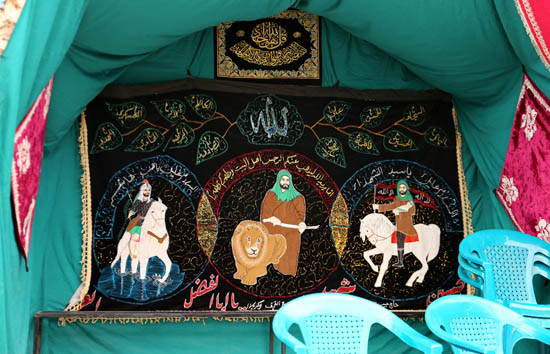

 Mehdi Tavasoliyan’s exhibition of old Natanz is above the entrance. Mehdi fumbles with the lock, the door opens. Under the centuries-old arch, in a circle, the city comes to life, as it was in Mehdi’s childhood. Dollhouses, palace and apartment interiors, shops and workshops, faithfully furnished down to every small detail. Mehdi selects a tool, turns the miniature grinder, clicks the scissors: everything works. It’s just that the shopkeepers don’t loudly advertise their wares and the assistant doesn’t steal a handful of pistachios the size of an ant’s egg.
Mehdi Tavasoliyan’s exhibition of old Natanz is above the entrance. Mehdi fumbles with the lock, the door opens. Under the centuries-old arch, in a circle, the city comes to life, as it was in Mehdi’s childhood. Dollhouses, palace and apartment interiors, shops and workshops, faithfully furnished down to every small detail. Mehdi selects a tool, turns the miniature grinder, clicks the scissors: everything works. It’s just that the shopkeepers don’t loudly advertise their wares and the assistant doesn’t steal a handful of pistachios the size of an ant’s egg.
I wonder what it takes for a person to put so much energy into creating such a world. Above all, time, a lot of time, and they have it here. Then the joy of babbling. And last but not least, a great, nostalgic devotion to the world that has completely disappeared here in Natanz, as in the whole of Iran, with shocking speed. In Mehdi’s life, this world that had been stable for centuries, changed more than in the life of any of his ancestors.
The last workshop of the evoked bazaar belongs to the photographer, with a large tripod Hasselblad in the door, and Qajar-era photographs on the walls. I know these pictures well, I recently wrote about them for a Spanish journal of art history. I am thinking that if Mehdi had also made the camera work, it would now be possible to lift from it the images of Pahlavi-era Natanz on small glass negatives. And then Mehdi, as if reading my thoughts, steps to the door, puts on the clothes of an ancient picture-shower at a fair, and twists the control arm of a machine that I have never seen before. It is an early 20th-century Persian portable cinema. The spectators knelt in front of the stovepipes protruding from the machinery, in which thick lenses magnified the brown archival photos slowly circulating in front of them. Photos of a world that belonged to the past even in Mehdi’s childhood, but when viewed from here, the other side of the great changes, the two merge into one another.

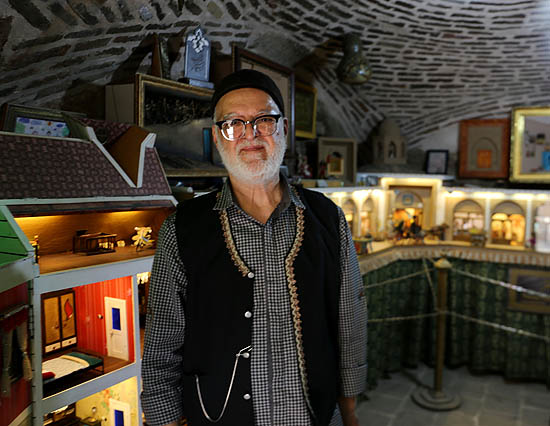
 The multi-day holiday of Ashura is also a time of great travel for most Iranian families. The main square of Isfahan is colored by rarely seen eastern and southern Iranian folk costumes. They came to see their country’s former capital and still its most beautiful city. They take photos with the wonderful arcades, domes and fountains, fly kites, slide around the square in hansoms during the day, and at dusk they have a picnic on the lawn of the main square and at the edges of the pools, many young women without scarves or fear.
The multi-day holiday of Ashura is also a time of great travel for most Iranian families. The main square of Isfahan is colored by rarely seen eastern and southern Iranian folk costumes. They came to see their country’s former capital and still its most beautiful city. They take photos with the wonderful arcades, domes and fountains, fly kites, slide around the square in hansoms during the day, and at dusk they have a picnic on the lawn of the main square and at the edges of the pools, many young women without scarves or fear.
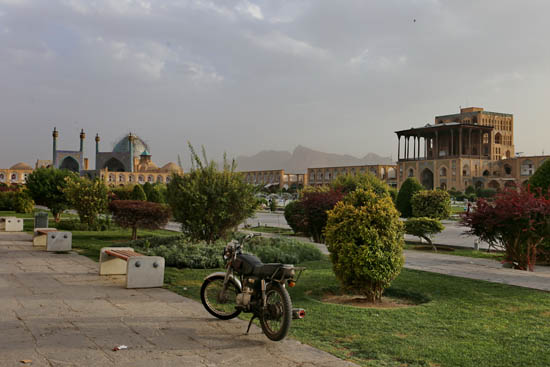

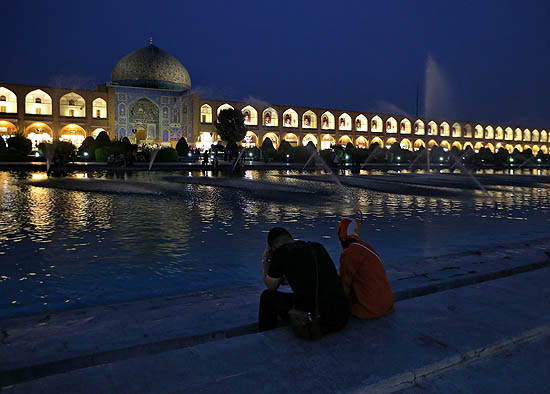
 We have dinner again at Hajji Mirza’s restaurant, just like last year: chelo kubdari, i.e. minced meat kebab with saffron rice, and beryân, ground lamb meat seasoned in two ways and spread on a pita. And again, I take pictures of the decoration reminiscent of a good antique shop. It’s not like I left out something last year, but because it is so good. And to draw your attention that most of the copper animals on the shelves used to be ornaments of old alamats, so this day is actually their holiday as well.
We have dinner again at Hajji Mirza’s restaurant, just like last year: chelo kubdari, i.e. minced meat kebab with saffron rice, and beryân, ground lamb meat seasoned in two ways and spread on a pita. And again, I take pictures of the decoration reminiscent of a good antique shop. It’s not like I left out something last year, but because it is so good. And to draw your attention that most of the copper animals on the shelves used to be ornaments of old alamats, so this day is actually their holiday as well.
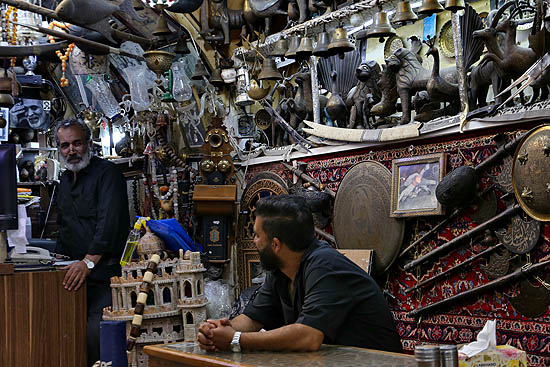


The Ashura decorations have already been taken down in Isfahan’s two large mosques which also serve tourism and, being large mosques, do not have their own community: the Shah Mosque on the main square and the Friday Mosque in the old town. But it is still up in the smaller mosques, as the series of commemorations continues for another ten days.  So in the Imamzadeh Ahmad mosque, not far from the main square, in the artisans’ bazaar. The large posters we have already seen: the women mourning the fallen imamzadehs, Abolfazl’s hand with Hossein’s bloody feather, and a large panel of Imam Hossein fighting heroically on his white horse against the black shadows.
So in the Imamzadeh Ahmad mosque, not far from the main square, in the artisans’ bazaar. The large posters we have already seen: the women mourning the fallen imamzadehs, Abolfazl’s hand with Hossein’s bloody feather, and a large panel of Imam Hossein fighting heroically on his white horse against the black shadows.
About Imamzadeh Ahmad, who rests here, it is not possible to exactly know how he is related to the twelve imams (imamzadeh means an imam’s son or descendant). But he is not alone in this. Iranian popular religiosity respects the graves of many imamzadehs while it is not certain who the person is, and sometimes it is certain that he is not the one who is honored there. In fact, it is not for him that we made a pilgrimage here, but because the great contemporary artist and art historian Parviz Tanavoli writes in his album Lions of Iran that the oldest surviving lion-shaped tombstone stands in the courtyard of this mosque. Such tombstones were erected by the nomadic tribes of the Zagros Mountains, primarily by the Bakhtiaris, for their chiefs, outstanding warriors, or, as they told me there, the bozorgân, the great ones, which provides a surprising etymology for the Hungarian word boszorkány (witch, wizard).
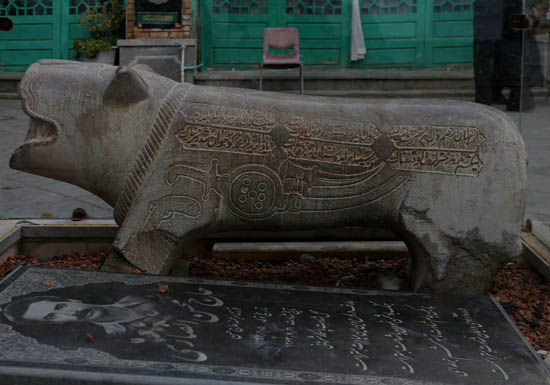
We can find the stone, it is kept under glass. As to its age, it is significant that the lion already carries carved firearms on its side. He holds a human head in his mouth, as if to show the fate of whoever attacks the grave.
But at least as interesting is the large stone slab that I am searching for here on the basis of Jabar Ansari’s
History of Isfahan and Rey. He writes about this:
“Mahmud Ghaznavi brought a stone from Somnath in India. It is said that the stone belonged to the most important idol in that country. The stone went to Isfahan and was cut in two a hundred year later. One half has become a lintel in Vazir Tahmasb’s madrasa, while the other half was dragged on the ground [out of contempt for the idol], and then taken to Emamzadeh Ahmad’s mausoleum.”
Mahmud (998-1030) was the founder of the Ghaznavid Seljuk Sultanate ruling over Iran, while Somnath one of the main shrines of Siva in Gujarat, India. It was built in the first centuries AD, and became one of the most important Indian pilgrimage sites. The Muslim attacks that started around 1000 destroyed it several times. The very first one of these was led by Mahmud Ghaznavi.
So much as it was easy to discover the bozorgân-lion in the middle of the courtyard, that much was it difficult to find the Somnath stone in the mosque. We are about to give up when a young master comes in from the bazaar to fill his demijohn with fresh water from the mosque’s well. I tell him what we are looking for. He smiles at me: “Well, it is not here, but outside.” He takes us out into the street and points at the ledge of the wooden window of the mausoleum. This stone covers the Imamzadeh’s grave, with only its carved edge sticking out into the street. It is not clear what is written on it and in what language, but it is likely that the inscription in Arabic letters was created after it was moved here.

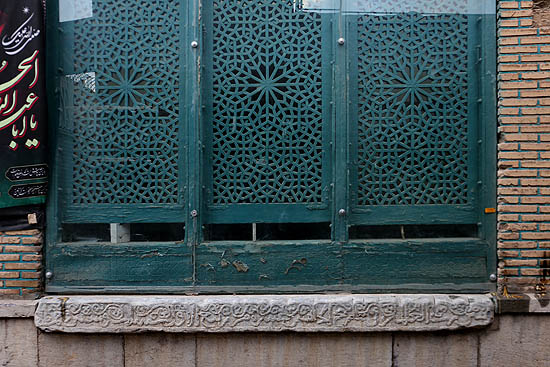
 We have to visit one more place in Isfahan, Hajj Mahmud’s beryâni. A beryâni is a place where you can eat beryân, the typical lunch of Isfahan, and nothing else. And what is beryân? Mutton soaked in onion-salt water, then ground and mixed with little cinnamon and dried mint, sometimes with a little liver, fried in a copper pan, spread on fresh flat bread, sprinkled with walnuts or almonds, and served with fresh vegetables and onions. Already the great French travelers of the 17th century, Jean-Baptiste Tavernier and Jean Chardin wrote about it in their Persian travelogues, and the latter also published two recipes for it. And the West’s interest in it has not waned since then. Anthony Bourdain dedicated a special episode to Hajj Mahmud’s beryâni in his series on the special cuisines of the world. This is where we are heading now. Their beryân is really not bad, but that of the aforementioned Hajji Mirza outshines it. Bourdain cannot know everything either.
We have to visit one more place in Isfahan, Hajj Mahmud’s beryâni. A beryâni is a place where you can eat beryân, the typical lunch of Isfahan, and nothing else. And what is beryân? Mutton soaked in onion-salt water, then ground and mixed with little cinnamon and dried mint, sometimes with a little liver, fried in a copper pan, spread on fresh flat bread, sprinkled with walnuts or almonds, and served with fresh vegetables and onions. Already the great French travelers of the 17th century, Jean-Baptiste Tavernier and Jean Chardin wrote about it in their Persian travelogues, and the latter also published two recipes for it. And the West’s interest in it has not waned since then. Anthony Bourdain dedicated a special episode to Hajj Mahmud’s beryâni in his series on the special cuisines of the world. This is where we are heading now. Their beryân is really not bad, but that of the aforementioned Hajji Mirza outshines it. Bourdain cannot know everything either.
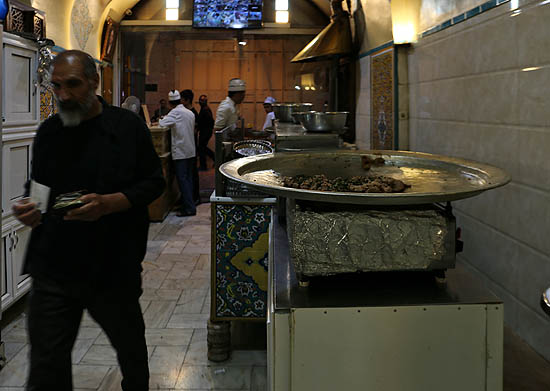

Hajj Mahmud’s beryâni is in the bazaar, at the end of the bazaar’s long main corridor towards the Friday Mosque. But you don’t have to walk the one-and-a-half kilometer long section from the main entrance to it (although it is worth it), but if you are hungry, you can also enter the bazaar from the side. And then you will be richer for the experience.
Isfahan’s old town, especially the area around the bazaar, was full of old merchant houses, caravanserai courtyards, small alleys and other exciting historical places still twenty years ago, when I was here for the first time. Since then, there has been unprecedented land speculation in the old town. These places are being demolished one by one and soulless modern buildings are being built in their place. As most of the old buildings are to some extent protected as monuments, they cannot just go at them with a bulldozer: they have to wait until they reach such a state that there is no other remedy for them. I have seen and still see several beautiful, townscape-wise and historically valuable objects, being destroyed in this way. Now I see the same thing on  Haroneyeh Street, leading to the Friday Mosque from the south. Here there have been, at least since the Qajar period, but perhaps even earlier, large multi-storey merchant houses with spacious inner courtyards, which served as caravansarais, warehouses and wholesale trade centers. By now the houses become empty, the courtyards destroyed, and only the façades still defy the challenge of time. This street was already in contact with the Jewish quarter, and many of the trading houses’ owners were Jews. The map still marks the Golbahar synagogue here, next to them, but no trace of it can be found on the site, and the neighboring shopkeepers also don’t know about it.
Haroneyeh Street, leading to the Friday Mosque from the south. Here there have been, at least since the Qajar period, but perhaps even earlier, large multi-storey merchant houses with spacious inner courtyards, which served as caravansarais, warehouses and wholesale trade centers. By now the houses become empty, the courtyards destroyed, and only the façades still defy the challenge of time. This street was already in contact with the Jewish quarter, and many of the trading houses’ owners were Jews. The map still marks the Golbahar synagogue here, next to them, but no trace of it can be found on the site, and the neighboring shopkeepers also don’t know about it.
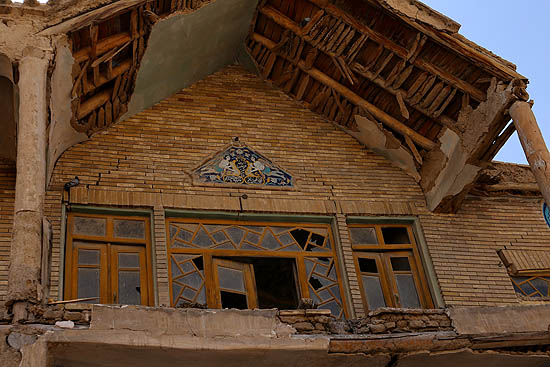

We are still eating Hajj Mahmud’s beryân, when the Ashura songs, which we first heard in the Kashan bazaar, blare from a loudspeaker right next to us, in the corridor of the bazaar. We will witness the same ceremony. As on the day before Ashura, the merchants of the bazaar also march up for the ten following days, ritually mourning Hossein and his companions. Here, at the eastern end of the Isfahan bazaar, there is no magnificent hosseiniye like the Timche-ye Amin od-Dowle in Kashan, so the square in front of the thousand-year-old Friday Mosque is declared an occasional hosseiniye, this is the goal of the groups marching under the alams. The women and children have already gathered here. They are settling down on carpets and chatting. Young boys serve them soft drinks and sweet saffron rice in small glasses. A small child, perhaps with his mother’s encouragement, perhaps on his own initiative, takes two more glasses of rice and brings them over to the two strangers standing by the pillar with cameras.
Isfahan’s Friday Mosque, which was probably founded in the 8th century on a former Zoroastrian shrine, is the only mosque in Iran, and perhaps in the entire Muslim world, that does not stand isolated from the surrounding buildings and shows up its façade significantly, but is integrated into the fabric of the surrounding city. The bazaar’s arches and shops flow around it, they are clinging to its walls. During the course of history, it had twelve gates, of which only two are open today. The Ashura ceremony takes place right in front of the main gate, kept closed for the occasion. While the believers gather, we go around the mosque to take photos of the twelve gates. We manage to find perhaps four, the rest being swallowed up by the bazaar. They could only be approached from shops and workshops, but these are also closed due to the holiday.
Meanwhile, the processions have already started towards the main gate. By the time we get back, they have already lined up in two rows on both sides of the corridor in front of the main gate, and the mourning ceremony begins with singing and rhythmic chest beating. We watch for a while and take pictures, then we set off with Wang Wei to tour the small medieval synagogues of the nearby Jewish quarter. I know eight of them, but there are supposedly more. I will write about them in a separate post. By the time we get back to the mosque, the ceremony is already over. The crowd is dispersing, many leave, but many stay to chat and drink tea. We are also invited. We accept it with thanks, we answer who we are, where we came from, we praise Iran and Isfahan. The children are particularly interested in us, and invite us to play. We take turns photographing them with Wang Wei. We ask one of the young mothers for her WhatsApp number, we will send her the photos in the evening.
This is the end of this year’s Ashura for us. From Isfahan, we set off on new discoveries: up to the Zagros Mountains, to the end-of-the-world Bakhtiari village of Sar Agha Seyyed, then down south to Sarvestan, the ancient seat of the Sassanid kings, and finally up to Tehran. I will write about these in separate posts. We started Ashura in the bazaar, and we end it in the bazaar as well. It was a great experience, as always, a little personalized presentation of the beauty of Persia and the kindness of the Iranians. We’ll be back for more.
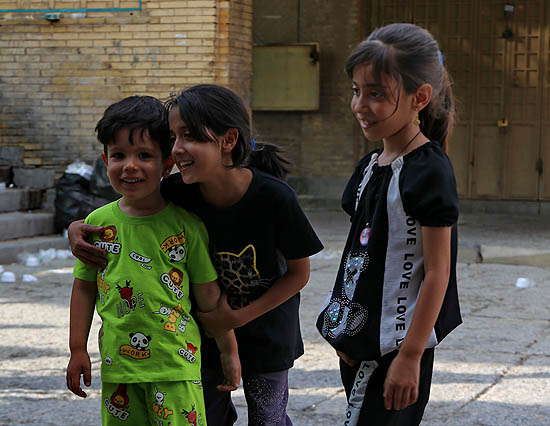
í
![]() China, especially the western part, is full of small historic towns and villages. You will, however, look for them in vain in any Western-language guidebook. I don’t know what came first, the chicken or the egg: whether they aren’t in them because Western tourists don’t come to these hidden parts of China anyway, being satisfied with the Great Wall and the Xian Clay Army for those two weeks, or they don’t come because the guidebooks don’t talk about these parts.
China, especially the western part, is full of small historic towns and villages. You will, however, look for them in vain in any Western-language guidebook. I don’t know what came first, the chicken or the egg: whether they aren’t in them because Western tourists don’t come to these hidden parts of China anyway, being satisfied with the Great Wall and the Xian Clay Army for those two weeks, or they don’t come because the guidebooks don’t talk about these parts.







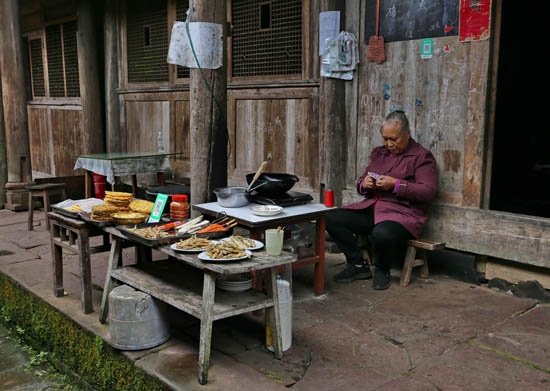








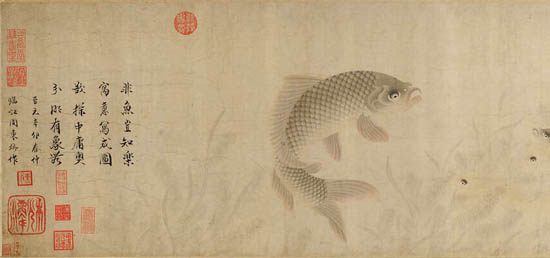
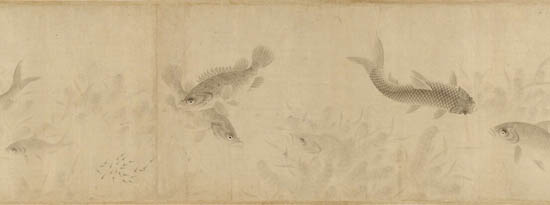
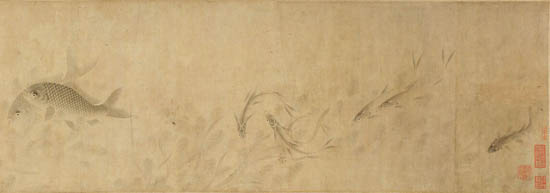





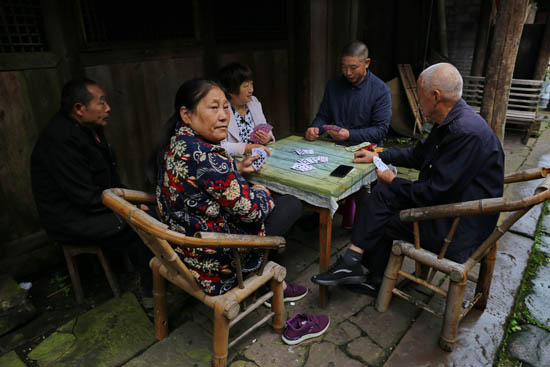

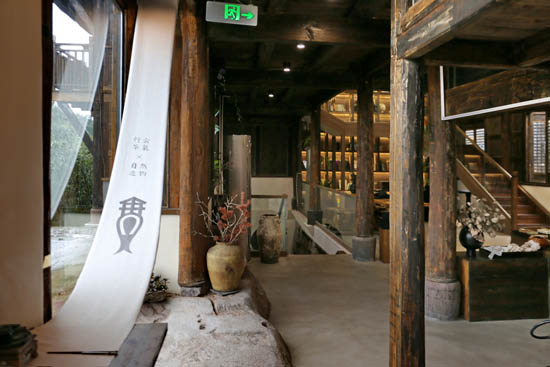




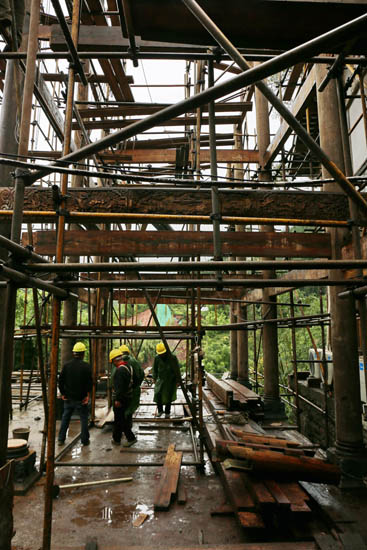


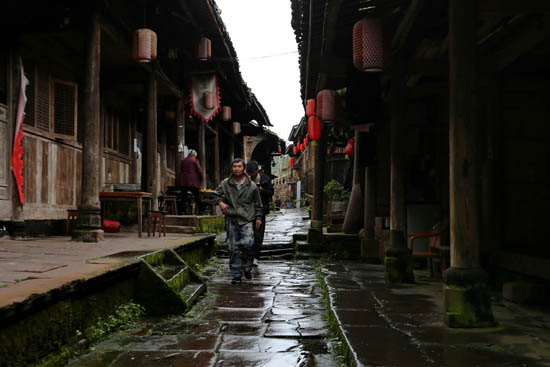


































 The Zoroastrian religion was named after its founder, the Eastern Iranian Zarathushtra (Zoroaster in Greek). He lived sometime between the 12th and 6th centuries BC and transformed the local version of the ancient Indo-European religion of twelve chief gods under one supreme god into the first monotheism. In his teaching, the chief gods are actually only archangels – the twelve Persian months still bear their names –, and there is only one god, Ahura Mazda (meaning the greatest and the wisest), who created them as well. Ahura Mazda created the world to be good, but not perfect: from the beginning it contains the evil in the form of decay (entropy), which was later personified in the form of the evil Ahriman. Man’s main purpose is to work against entropy as a kind of maintenance staff, to restore the decaying world, to bring joy and happiness into it. For this, he can expect no reward, and no punishment for negligent maintenance. People do good for its own sake, because it is the only right and meaningful action. Zoroastrianism has neither heaven, nor hell. At the end of the maintenance work – that is, death – man’s work clothes, that is, his body is cleaned up by vultures, and his soul – everyone’s soul – returns to Ahura Mazda.
The Zoroastrian religion was named after its founder, the Eastern Iranian Zarathushtra (Zoroaster in Greek). He lived sometime between the 12th and 6th centuries BC and transformed the local version of the ancient Indo-European religion of twelve chief gods under one supreme god into the first monotheism. In his teaching, the chief gods are actually only archangels – the twelve Persian months still bear their names –, and there is only one god, Ahura Mazda (meaning the greatest and the wisest), who created them as well. Ahura Mazda created the world to be good, but not perfect: from the beginning it contains the evil in the form of decay (entropy), which was later personified in the form of the evil Ahriman. Man’s main purpose is to work against entropy as a kind of maintenance staff, to restore the decaying world, to bring joy and happiness into it. For this, he can expect no reward, and no punishment for negligent maintenance. People do good for its own sake, because it is the only right and meaningful action. Zoroastrianism has neither heaven, nor hell. At the end of the maintenance work – that is, death – man’s work clothes, that is, his body is cleaned up by vultures, and his soul – everyone’s soul – returns to Ahura Mazda.




















































































